Rothesay Tramways Company
Summary
Several photos exist from the first two decades of the Rothesay Tramways Company, during which time it was an independent concern, operating horse trams. These photos clearly show that staff wore a variety of informal attire, including heavy jackets and trousers, with headwear invariably the ubiquitous bowler hat (particularly for drivers), or in later years, the flat cap. The use of informal attire was common practice amongst horse tramway operators, and indeed many of them, like the Rothesay Tramways Company, never issued uniforms or insignia of any kind.
The company was taken over prior to electrification, becoming a subsidiary of the much larger British Electric Traction Company Ltd (BETCo), a concern which at its zenith either owned, part-owned or leased almost 50 tramway concerns across the British Isles. For the inauguration of electric services, staff were issued with double-breasted jackets with five pairs of buttons (of the standard BETCo pattern — see link), three pockets (with flaps) and lapels; by analogy with other BETCo systems, the latter probably bore embroidered system initials on both sides, most likely ’R T C’ or 'R T Co', though these cannot be made out with any certainty on surviving photographs. Caps were soft-topped with a glossy peak, and bore the standard BETCo 'Magnet and Wheel' cap badge, below which an employee number was carried, all badges almost certainly in brass to match the buttons.
This style of uniform appears to have been relatively quickly superseded by a double-breasted 'lancer-style' of tunic with two rows of five buttons (narrowing from top to bottom) and upright collars; the latter bore an employee number on the bearer's left-hand side (in individual brass numerals) and system initials, 'R T', on the right-hand side (in individual brass letters). The caps were probably altered at the same time to a military style with a tensioned crown (top), but with the insignia unchanged.
The uniform was changed one last time — probably in the 1920s — to a more modern single-breasted design with four buttons, breast pockets (with button closures) and lapels; it is currently unclear what insignia it bore.
Staff were also issued with double-breasted greatcoats with two rows of four buttons, and three or four pockets (with flaps). These carried embroidered insignia in the early years — presumably the system initials — but appear to have been left plain in later years.
Following the sale of the RTCo to Scottish Motor Traction (soon thereafter to become 'Western SMT'), all vestiges of BETCo branding would have been removed or replaced. Photographs from this era show staff in a variety of attire, some of it clearly informal, along with light-coloured dust coats or gabardines. Caps remained military in style, but seem to have borne of variety of cap badges, none of which appear to have been the standard Scottish Motor Traction (or Western SMT) patterns. Although a diamond-shaped 'RTCo' badge was certainly used on the buses (probably right up to 1950), there is no evidence whatsoever that this was worn by tramway staff.
Inspectors wore typical tramway inspector garb, i.e., single-breasted jackets with hidden buttons (or a hook and eye affair), two slit breast pockets and upright collars; the latter bore Inspector in embroidered script lettering on both sides. The jackets (including the slit breast pockets) were edged in a finer material than the main jacket, the sleeves also being embellished with a chevron of the same material. Headgear took the form of a soft-topped cap, which carried the standard BETCo 'Magnet & Wheel' cap badge, below which was the grade - Inspector - in embroidered script lettering. This style of cap was fairly quickly superseded by a military style, the badges remaining the same. The uniform was probably changed to a more modern design in the late 1920s or early 1930s, namely: to a single-breasted design with four buttons, two breast pockets (with button closures) and lapels; no badges were worn.
Inspectors were also issued with double-breasted overcoats with two rows of four plain buttons, three hip/waist-level pockets and lapels; the latter carried the grade - Inspector - in embroidered script lettering.
The RTCo also employed the services of a traffic inspector, whose uniform appears to have been very similar to those worn by inspectors, though possibly without the edging. Caps were the same military style as worn by inspectors, but with the grade Traffic Inspector.
Female staff were employed during the Great War to replace male staff lost to the armed services, not only as conductresses, but also as motorwomen, along with a single inspectress. Surviving photographs are few in number, but suggest that the ladies were allowed to wear informal attire, though covered by a long, light-coloured dust coat; these coats do not appear to have borne any insignia. Headgear took the form of a dark-coloured straw bonnet with a hat band, upon which the usual 'Magnet & Wheel' cap badge was affixed.
For a detailed account of the tramway, see 'The Rothesay Tramways Company 1879-1949' by Ian L Cormack (Scottish Tramway and Transport Society; 1986) and 'Rothesay's Trams and Buses' by A W Brotchie (Stenlake Publishing Limited; 2014).
Images
Horse tram drivers and conductors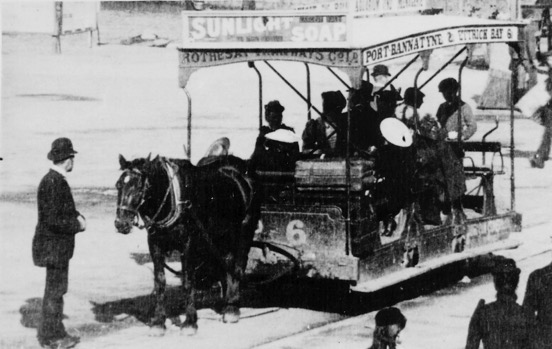
The driver of Horsecar No 6 waits for his conductor to collect fares at Guildford Square in 1892. In common with many horse-drawn tramways of the late Victorian era, the driver is wearing a bowler hat. Photo courtesy of the Tramways and Light Railway Society, with thanks to David Voice.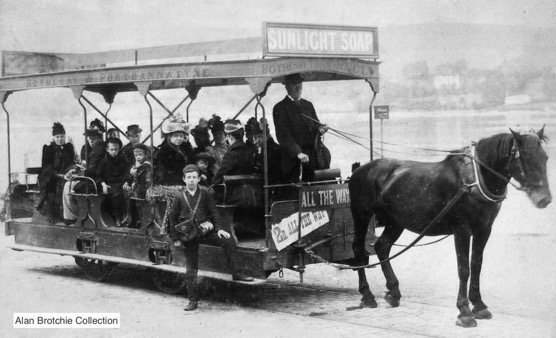
Conductor and driver pose for the cameraman at Port Ballatyne — photo undated, but probably taken in the mid-to-late 1890s.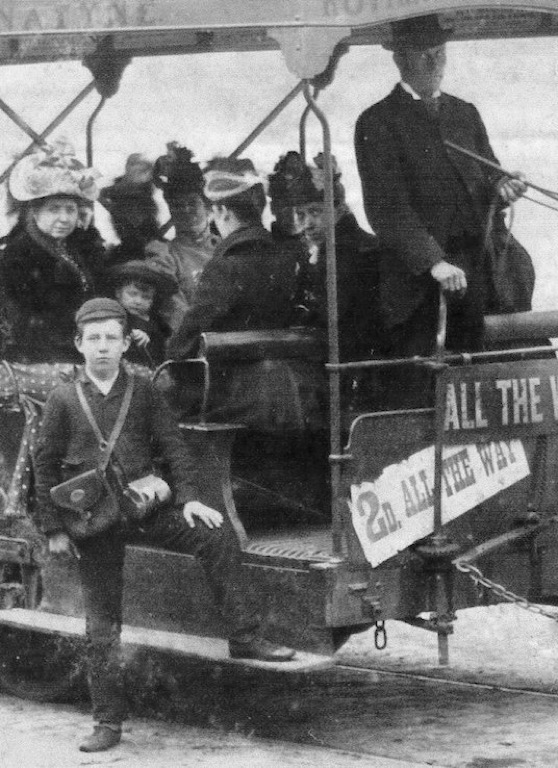
A blow-up of the above photo showing the fresh-faced conductor and his driver, John McNeil, both of whom are wearing informal attire, devoid of badges or licences.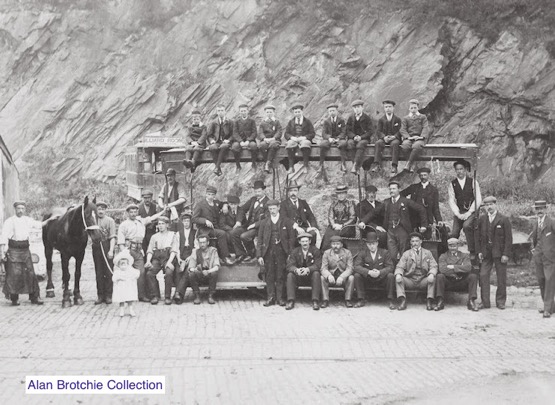
The manager, Archibald Robertson, his family and staff, pose for the photographer after the take-over by the British Electric Traction Company - photo undated, but probably taken in 1899 or 1900. Judging by other photos, most of the boys on the roof are probably conductors, whilst those in jackets and waistcoats are probably drivers.
Motormen and conductors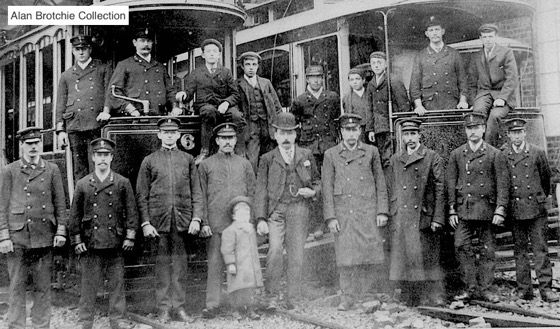
Staff (motormen, conductors and an inspector) at Pointhouse Depot in 1902. This shows the first style of uniform — double-breasted with lapels — which was quickly superseded by a more durable 'lancer-style' of tunic (see below). The central figure in the bowler hat is Archibald Robertson (the manager), whilst to his left is John McNeil (presumably the same man depicted at the helm of a horse tram in the late 1890s photo above). The man standing being the controls of Tramcar No 6 is Andrew Kernaghan, who later became an inspector.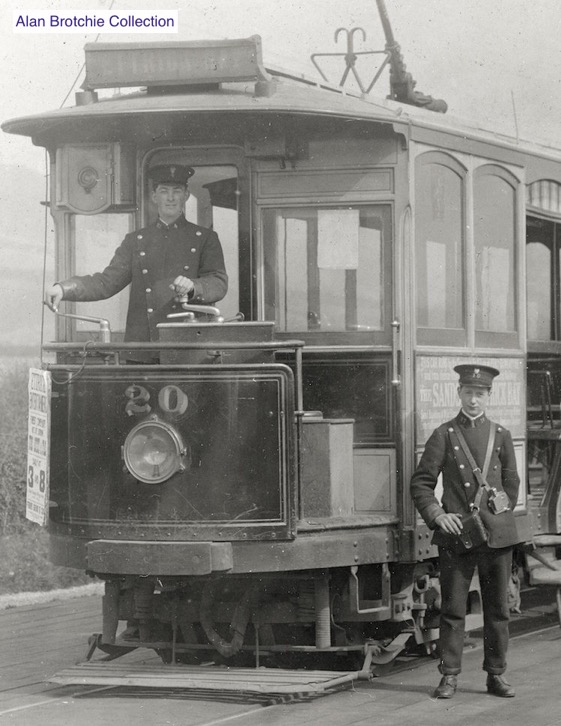
Motorman (Employee No 4) and conductor (Employee No 10) pose for the camera at Ettrick Bay, very probably around the time of its opening, or shortly thereafter (1905/6).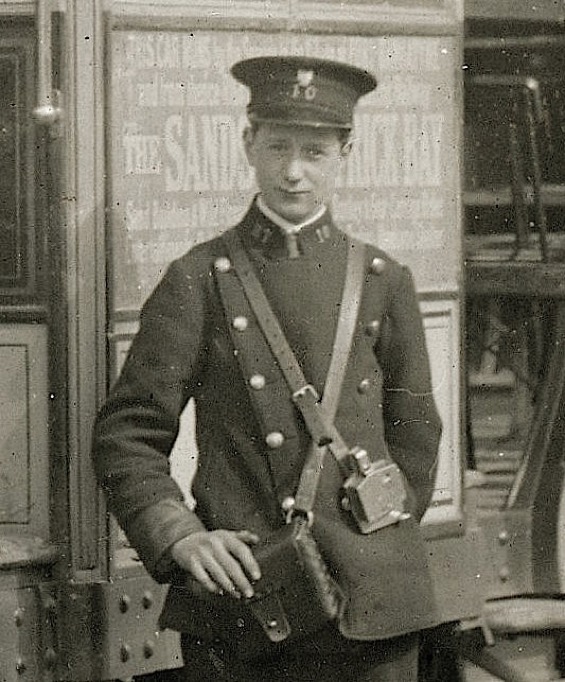
A blow-up of the above photo showing the conductor, whose cap and collar insignia are easily made out. The system initials on his right-hand collar are 'R T'.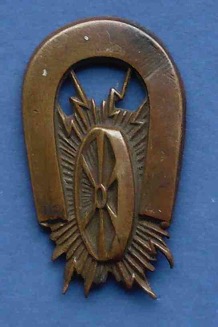
Standard British Electric Traction Company Limited ‘Magnet & Wheel’ cap badge — brass.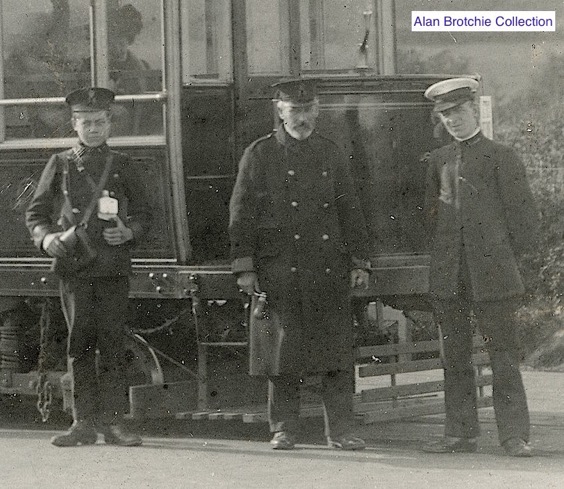
Conductor, motorman and an inspector with Tramcar No 7 at Ettrick Bay — photo undated, but probably late Edwardian.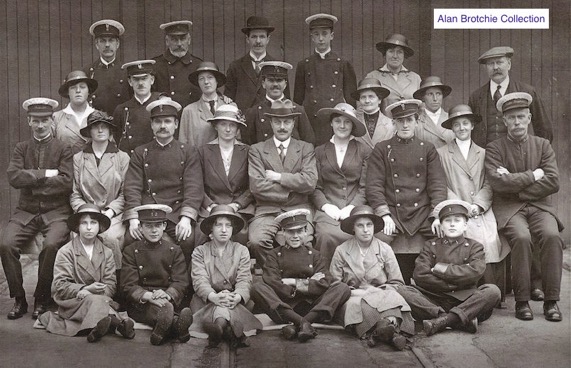
An excellent shot of RTCo staff at Pointhouse depot taken during the Great War; they are overwhelmingly young, old or female.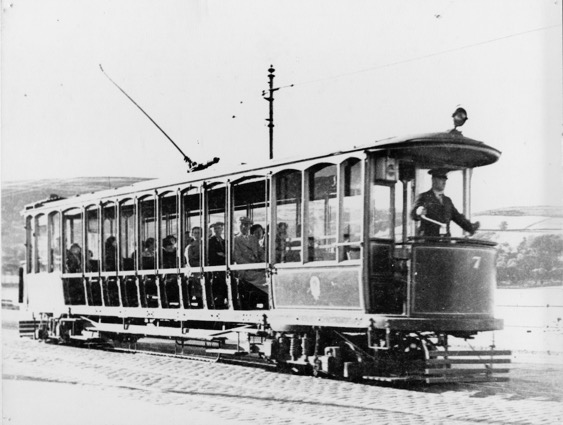
Motorman at the controls of Tramcar No 7 in the latter days of BETCo ownership — photo undated, but probably taken in the late 1920s judging by the passengers' clothing. Photo courtesy of the Tramways and Light Railway Society, with thanks to David Voice.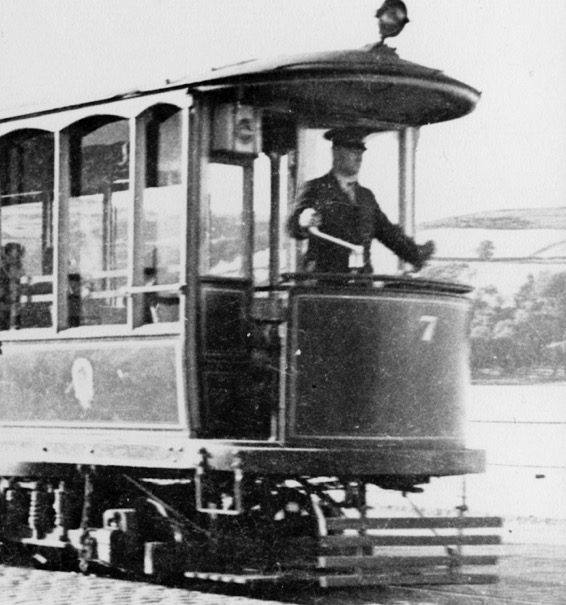
A blow-up of the above photo, which reveals the motorman to be wearing a single-breasted jacket with lapels. 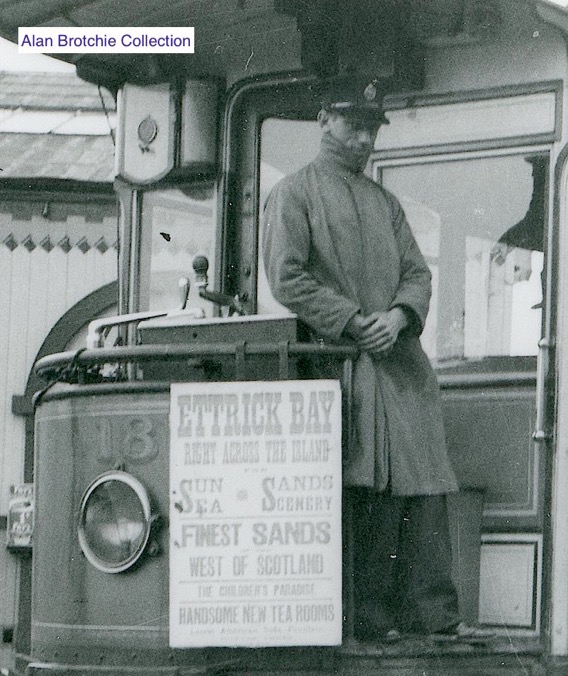
Motorman on the platform of a rather scruffy-looking Tramcar No 18 at Ettrick Bay in 1935. He his wearing a light-coloured dust or gabardine coat, and a cap with a large oval badge of unknown pattern. This shot was taken during the tenure of the Scottish Motor Traction Company, yet the badge bears no resemblance whatsoever to any badge issued by that company, nor to the diamond 'RTCo' badge later used on the buses (see below) .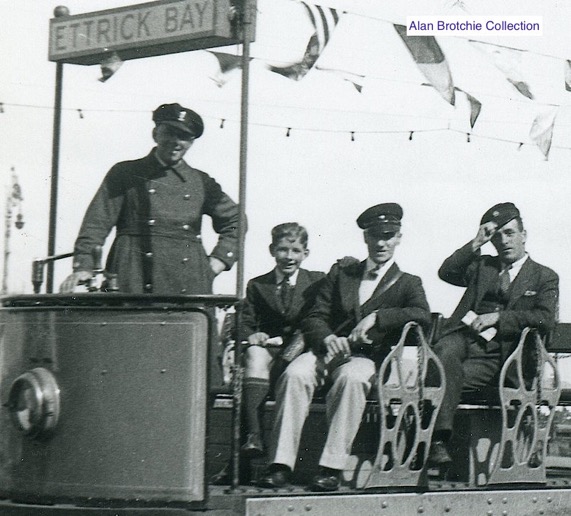
A motorman and two conductors pose for the camera aboard Tramcar No 11 at Guildford Square on the 8th September 1935. Apart from the caps, everything else appears to be non-standard, including the cap badges, at least two types being on display; it is unclear whether these badges were official issues.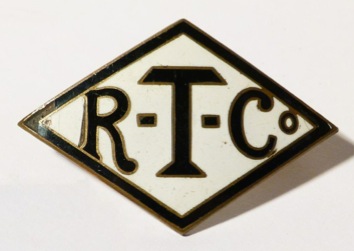
Rothesay Tramways Company cap badge — dark blue and white enamel. There is no evidence whatsoever that this badge was issued to tramway staff, so in all likelihood it was only used on the buses, which continued to run under that name long after the tramway had closed. Stephen Howarth Collection.
Senior staff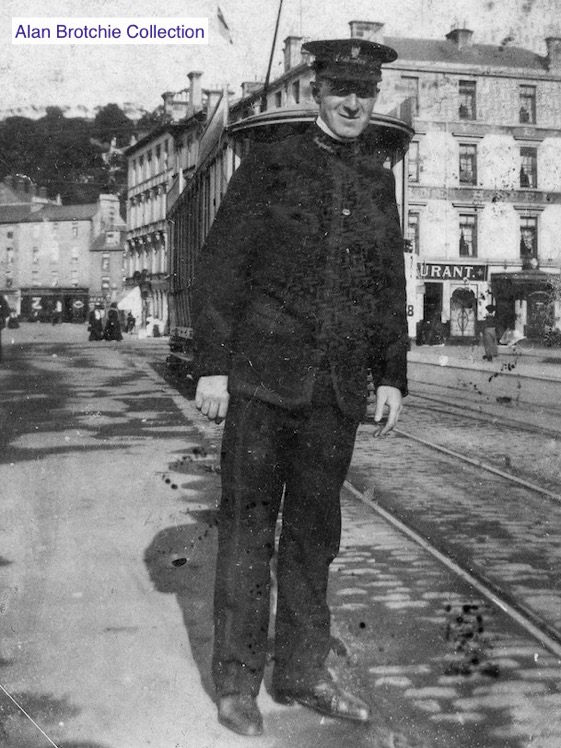
A rare (for any tramway) close-up of an inspector at work — photo undated, but from the fashions on display, certainly taken prior to the Great War, The subject is Inspector William McCallum, who served with the 1st/9th Battalion of the Durham Light Infantry, being killed at Ypres on the 28th of March 1918 (with thanks to his grandson, Brian McGregor, for this information). The location is the terminus at Guildford Square, Rothesay.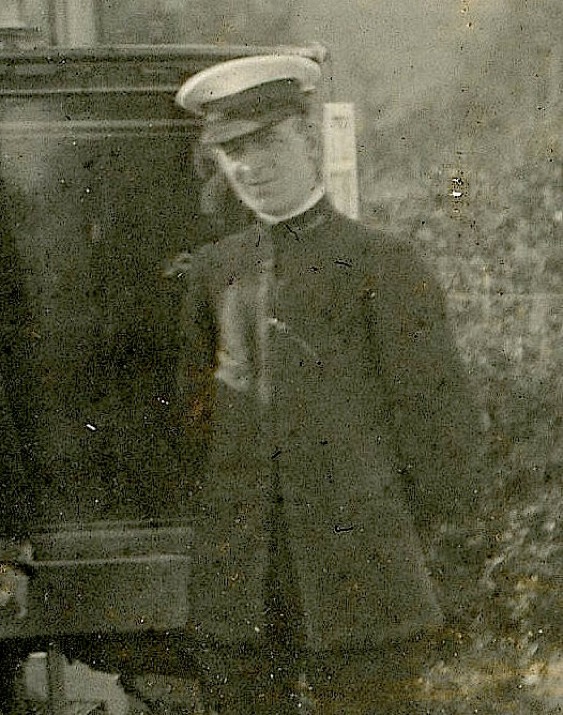
A blow-up of the photograph of Tramcar No 7 above showing the inspector, who would appear to be William McCallum.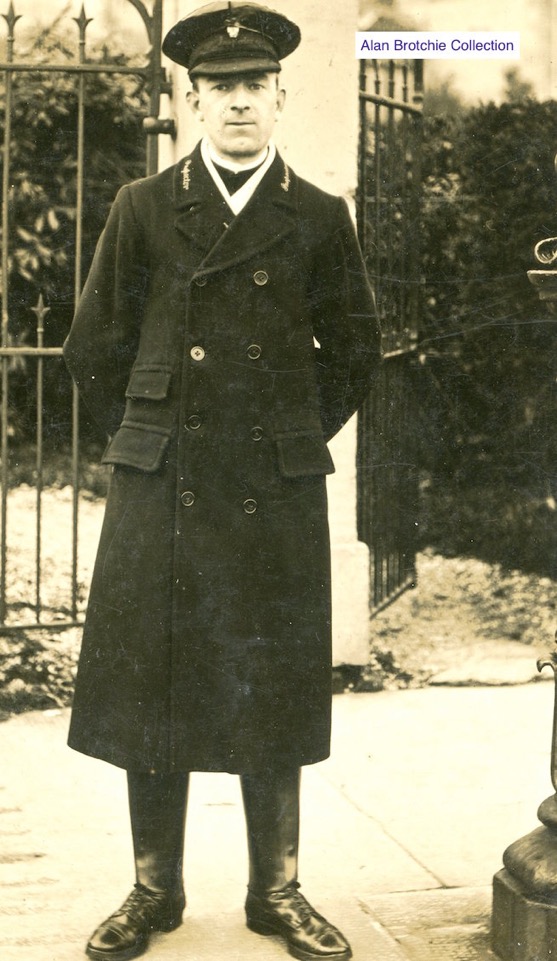
Inspector William McCallum again, this time in overcoat and highly polished gaiters — photo undated, but certainly taken prior to the Great War.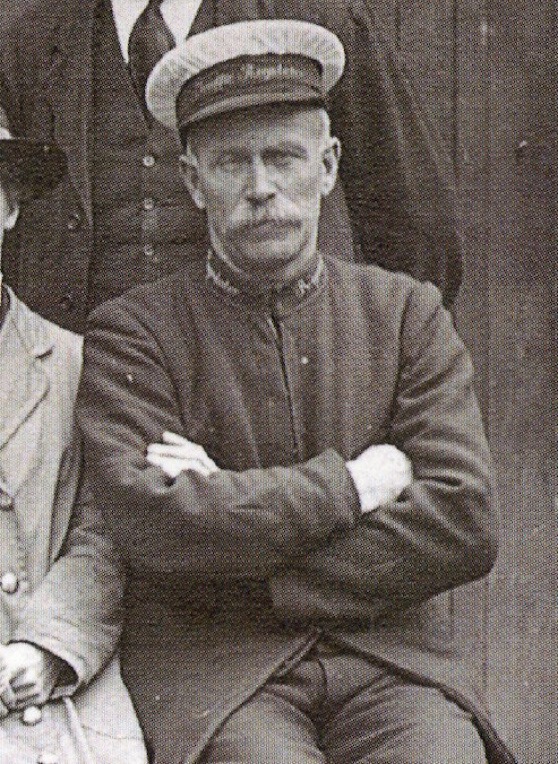
A blow-up of the Great War staff photo above showing the Traffic Inspector.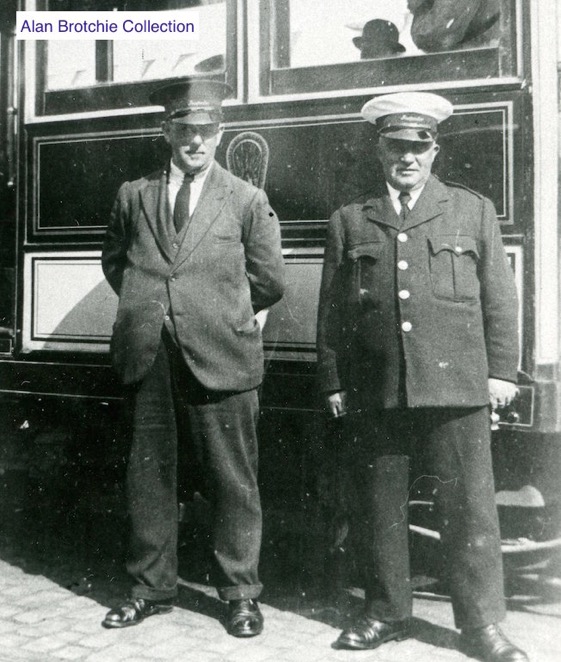
Inspector Andrew (Paddy) Kernaghan (right) and an unidentified colleague in BETCo days — probably taken in the late 1920s. Inspector Kernaghan is wearing a more modern single-breasted jacket with lapels, whereas his compatriot, although wearing an inspector's cap, is without a uniform; he may be part of the management acting as an inspector on one of the many busy days the RTCo enjoyed. Andrew Kernaghan is picture aboard Tramcar No 6 in the 1902 Pointhouse depot photo shown above.
Female staff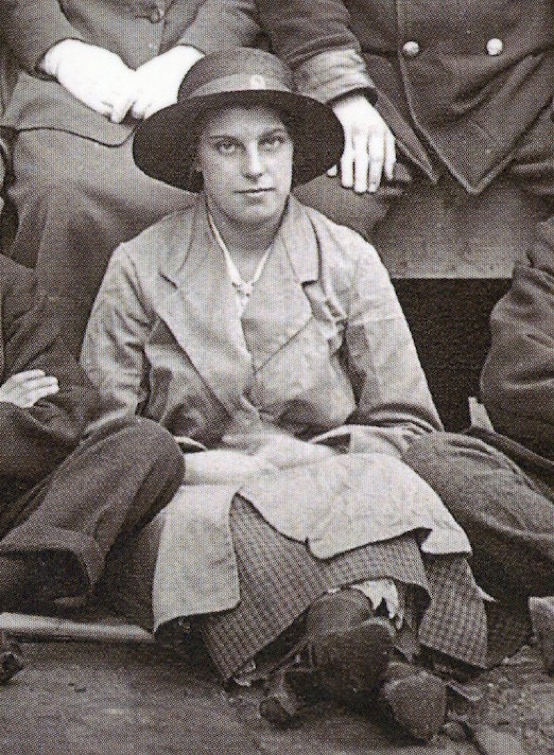
A blow-up of the Great War staff photo (see above) taken at Pointhouse depot. All the ladies present appear to be wearing informal attire, but covered by a light-coloured, company-issued dust coat, devoid of insignia. Most are wearing, like this lady, a dark-coloured straw bonnet with a hat band, to which a standard BETCo 'Magnet & Wheel' cap badge is affixed.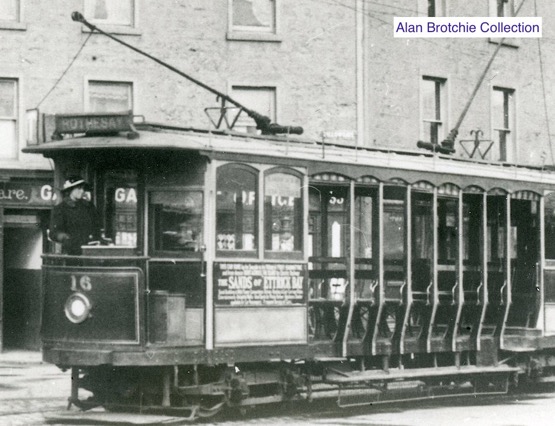
A rare shot of a Rothesay motorwoman at the controls of a tramcar (No 16 at Gallowgate) — photo undated, but almost certainly taken during the Great War.